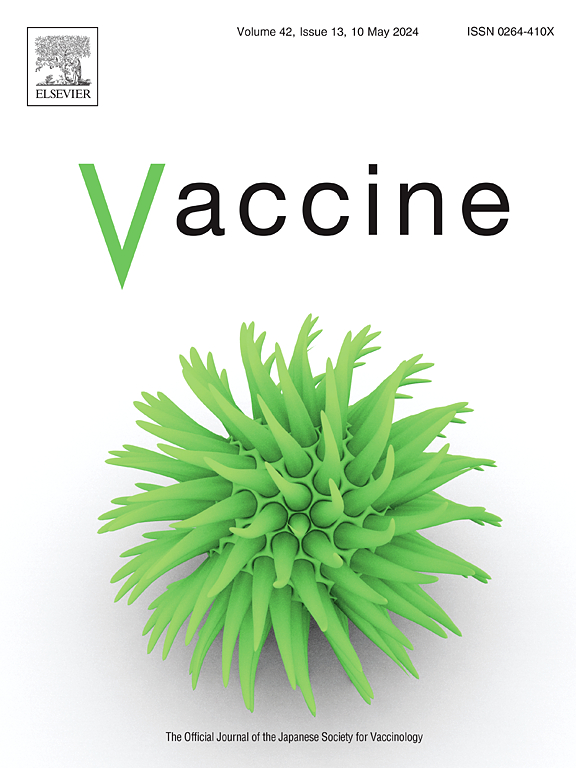加强小学生流感疫苗接种的校本干预措施
IF 4.5
3区 医学
Q2 IMMUNOLOGY
引用次数: 0
摘要
背景解决小学生疫苗接种率低的问题,有助预防流感爆发,保障公众健康。我们评估了以学校为基础的干预措施在提高中国贵州小学生流感疫苗接种率方面的有效性。方法于2023年12月,由四所小学的家长和学生参与。在基线和2024年4月30日分别收集基本信息和疫苗接种史。在纳入的9437名学生中,9168名(97.15%)在2023-2024年冬季未接种疫苗。在一所学校,家长收到了信息材料(信息组);在另一组中,儿童接受了校园流感疫苗接种服务(SIV组)。第三所学校同时获得信息材料和疫苗接种服务(信息+SIV组)。第四组是对照组,没有接受任何干预。自干预以来,2023-2024赛季未接种疫苗的学生中有1.11%(19/1713)在对照组接种了疫苗。疫苗接种率显著高于疫区(5.30%,P <;0.001), SIV (13.99%, P <;0.001),信息+SIV组(12.96%,P <;0·001)高于对照组。SIV组和Information+SIV组的疫苗接种率高于Information组(P <;SIV组与Information+SIV组间差异无统计学意义(P = 0.28)。在853名接种疫苗的学生中,44.78% (n = 382)为首次接种者。先前有疫苗接种史的人比他们的同行更有可能接种疫苗。5-6年级的学生和一些少数民族群体接种疫苗的可能性较低。以学校为基础的干预措施,特别是校园疫苗接种,可以提高小学生的疫苗接种率。中国医学科学院医学科学创新基金(批准号:2022-12 M-CoV19-004), Science &;科技基础资源调查计划(批准号:2023FY100600),盖茨基金会(批准号:INV-023808, INV-006373),贵州省卫生健康委员会(批准号:gzwkj2024-215)。本文章由计算机程序翻译,如有差异,请以英文原文为准。
School-based interventions to increase influenza vaccination in primary school students
Background
Addressing low vaccination coverage in primary school students will help prevent influenza outbreaks and safeguard public health. We evaluated the effectiveness of school-based interventions in improving influenza vaccination rates among primary school students in Guizhou, China.
Methods
Parents and students from four primary schools participated in December 2023. Basic information and vaccination history were collected at baseline and on April 30, 2024, respectively. Among the 9437 included students, 9168 (97·15 %) were not vaccinated during the 2023–2024 winter season. In one school, parents received informational material (Information group); in another, children received on-campus influenza vaccination services (SIV group). A third school received both informational material and vaccination services (Information+SIV group). The fourth was the control group, receiving no intervention.
Findings
Since the intervention, 1·11 % (19/1713) of previously unvaccinated students in the 2023–2024 season were vaccinated in the control group. Vaccination rates were significantly higher in the Information (5·30 %, P < 0·001), SIV (13·99 %, P < 0·001), and Information+SIV groups (12·96 %, P < 0·001) than in the control group. The SIV and Information+SIV groups had higher vaccination rates than the Information group (P < 0·01), with no significant difference between the SIV and Information+SIV groups (P = 0·28). Among the 853 vaccinated students, 44·78 % (n = 382) were first-time recipients. Those with prior vaccination history had a higher likelihood of vaccination than their counterparts. Students in grades 5–6 and some ethnic minority groups had a lower likelihood of vaccination.
Interpretation
School-based interventions, particularly on-campus vaccinations, can increase vaccination rates among primary school students.
Funding
Chinese Academy of Medical Sciences Innovation Fund for Medical Sciences (grant number: 2022-12 M-CoV19–004), Science & Technology Fundamental Resources Investigation Program (grant number: 2023FY100600), Gates Foundation (grant number: INV-023808, INV-006373), and Health Commission of Guizhou Province (grant number: gzwkj2024–215).
求助全文
通过发布文献求助,成功后即可免费获取论文全文。
去求助
来源期刊

Vaccine
医学-免疫学
CiteScore
8.70
自引率
5.50%
发文量
992
审稿时长
131 days
期刊介绍:
Vaccine is unique in publishing the highest quality science across all disciplines relevant to the field of vaccinology - all original article submissions across basic and clinical research, vaccine manufacturing, history, public policy, behavioral science and ethics, social sciences, safety, and many other related areas are welcomed. The submission categories as given in the Guide for Authors indicate where we receive the most papers. Papers outside these major areas are also welcome and authors are encouraged to contact us with specific questions.
 求助内容:
求助内容: 应助结果提醒方式:
应助结果提醒方式:


